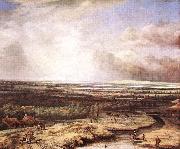|

|
|
Click to Enlarge
|
| Philips_Koninck
|
An Extensive Landscape with a Hawking Party
Philips Koninck3.jpg |
|
|
|
|
| Oil on canvas,
132 x 160 cm
National Gallery
London |
|
1619-1688
Dutch
Philips Koninck Gallery
Little is known of his history except that he was said to be a pupil of Rembrandt, whose influence is to be seen in much of his work. He painted chiefly broad, sunny landscapes, full of space, light and atmosphere; they are seen from a high perspective, allowing a prominent view of the sky. Portraits by him, somewhat in the manner of Rembrandt, also exist (e.g. see Joost van den Vondel); there are examples of these in the galleries at Copenhagen and Oslo. Of his landscapes, the principal are View at the mouth of a river at the Hague, with a slightly larger replica in the National Gallery, London; Woodland border and countryside (with figures by Adriaen van de Velde) at Amsterdam; and landscapes in Brussels, Florence (the Uffizi), Berlin and Cologne. Koninck, a prosperous businessman, appears to have painted few pictures during the last decade of his life.
Several of his works have been falsely attributed to Rembrandt and many more to his namesake and fellow townsman Salomon de Koninck (1609-1656), also a disciple of Rembrandt, whose paintings and etchings consist mainly of portraits and biblical scenes.
Both of these painters are to be distinguished from David Koninck (1636?-1687), also known as Rammelaar. David Koninck was born in Antwerp and studied there under Jan Fyt. He later settled in Rome, where he is stated to have died in 1687; this, however, is doubtful. His pictures are chiefly landscapes with animals and still life.
|
|
|
Prev Art Next Art |
|

